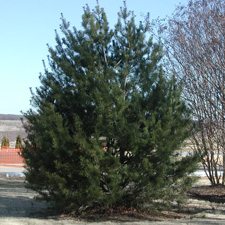Resource Library
Plant of the Week: Whitebark Pine (Lacebark Pine)
The University of Arkansas System Division of Agriculture does not promote, support or recommend plants featured in "Plant of the Week." Please consult your local Extension office for plants suitable for your region.
Plant of the Week
Lacebark or Whitebark Pine
Latin: Pinus bungeana

A tension always exists in gardening between fast growth and good end-results. Fast growers give quick returns, but they often fizzle out before the desired effect is achieved. The lacebark pine, arguably the most beautiful pine in the piney kingdom, is seldom seen in American gardens because of its slow growth - often not showing its true character until 100 years old.
Lacebark Pine, Pinus bungeana, grows as a flat-topped, picturesque, multiple trunked pine with side branches arising near the ground. Trees reach 50 feet tall with a spread of 20 to 35 feet. It’s a three-needle pine with dark green, stiff, 3-inch long needles that remain attached three to four years.
Young trees have light gray bark, but as trunks reach 2 to 3 inches in diameter they begin to exfoliate (peel) with the size of the plates increasing as the trunk increases in girth. While still young the patches are in shades of gray, brown and green, but as the tree ages into maturity after about 100 years, the trunk takes on a jig-saw puzzle look with patches of white and gray.
The accompanying photo of a 15-year-old specimen grows in Fayetteville on the UofA research farm. None now living will see it develop the white bark Ann Bridge saw in 1932 when she described the tree growing in Jietai Si, southwest of Beijing.
Quoting Bridge: “The white pine (what we now call lacebark pine) is the most improbable of trees - too good to be true; it is impossible to believe at first that some ingenious Chinese has not sandpapered its smooth trunk and boughs, and then given it several coats of whitewash.” The tree she was describing was the 900-year-old Nine Dragon Pine, with nine major limbs each the size of a tree.
Though first described near Beijing in 1831 by the Russian botanist Alexander von Bunge, it was not introduced into the West until Robert Fortune made his first collecting trip into China at the close of the first Opium War in 1845.
The National Arboretum in Washington DC has a number of fine specimens started from seeds collected in 1931 by USDA plant explorer P.H. Dorsett, a man having profound impact on Arkansas agriculture for it was he who introduced many of the early soybean lines into the United States. Dorsett, who collected seeds from the Nine Dragon pine described above, had difficulty gathering cones because, as soon as one hit the ground, there would be a scurry of activity to gather and eat the seeds - a sweet, nutty delicacy.
Lacebark pine is available in the nursery trade but it takes a bit of looking to find. It is an easy to grow, drought tolerant pine. The tree I grew averaged about a foot of growth a year over 15 years, so plant it as an isolated specimen where it won’t be overtaken by faster growing neighbors. Other than its inherent slowness, it is an easy to grow species with no problems seen so far.
By: Gerald Klingaman, retired
Extension Horticulturist - Ornamentals
Extension News - December 8, 2006
The University of Arkansas System Division of Agriculture does not maintain lists of retail outlets where these plants can be purchased. Please check your local nursery or other retail outlets to ask about the availability of these plants for your growing area.